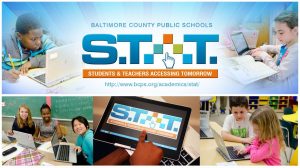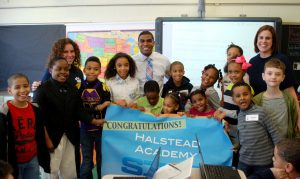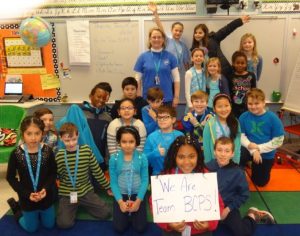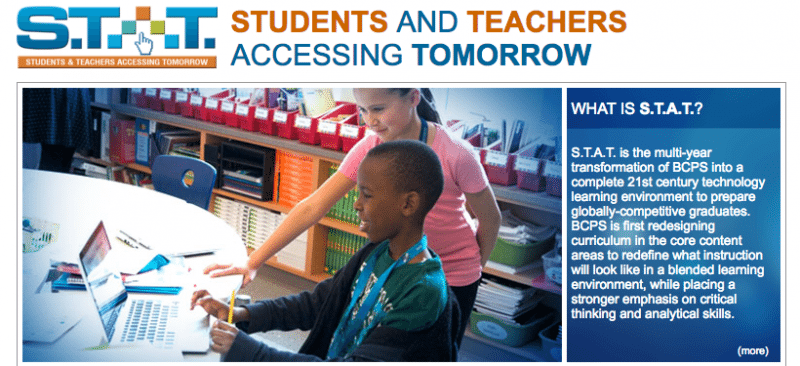Here is an op-ed from three principals at Baltimore County Public Schools in defense of the Students and Teachers Accessing Tomorrow (STAT) program, which will be providing all K-12 students with their own laptop and integrating more technology into the classrooms. The program has been criticized for being too costly and of dubious educational value. These principals, who all work at Lighthouse Schools (the first in the county to get STAT) disagree.
Welcome to three of the ten BCPS Lighthouse Schools. Although each of our schools reside in Baltimore County, we are located in very different areas, where students come to us with a variety of backgrounds and socio economics. We would like for you to join us on a typical day as we walk through our hallways and observe equitable instruction for all, because of the STAT initiative.
The best part of our day is spent in and out of classrooms working with our teachers and students. If you have never visited our schools we want to give you some insight into what REALLY goes on in a school with devices. Join us as we walk through our building … on any given day.
As I head down the hallway I hear conversations that intrigue me, so I join a 5th grade class discussing American history as they debate the start of the Revolutionary War. When I enter the room I observe students sitting in a circle asking higher level questions. As one student shares a questionable fact I see students using their devices collaboratively to research the answer to confirm the addition to the debated topic. In the other corner of the room I see the teacher checking in on students who are working together to create a digital presentation specific to defending their side of the British in the war.
As I leave this classroom to continue my travels I observe several 3rd graders using chart paper and markers to create an anchor chart. Each is able to tell me that they will use their product to explain how to solve for equivalent fractions to their classmates. I am so excited to see how students are owning and sharing their learning.

Halstead Academy
As I go into 1st grade I see students using their device to record their fluency from the leveled text they are reading. After their first read, they use a check list to self-assess themselves. One student did not feel that she did her best so, she re-recorded to increase her rate and articulation. The highest level of thinking is when students have the ability to self-evaluate themselves. It shows that they have a clear understanding of what is expected of them.
Music is in the air! Moving along I hear students playing various instruments. When I venture into the room I see some students accessing Discovery Boards on their devices as they learn about musicians, their music, and how the music makes them feel. They then have the option to choose their product to demonstrate their understanding. Some students select a traditional illustration while others use a digital tool to draw. Each are connected through writing to show how the song makes them feel using supports from their learning experience.
Continuing my journey with special areas, my art teacher is showing students how to create an electronic portfolio, archiving projects from one year to the next. Students are so motivated with the idea of monitoring their own growth in art for years to come in BCPS.

Mays Chapel Elementary
The next room has a substitute today. I planned to stop by to offer support and answer questions but find that the substitute has pulled a small group of students to read and discuss a story using questions the teacher posted online. Other students in the room are reading independently and responding to questions or accessing learning tiles through BCPSOne that the teacher had pushed out to them. Learning never skips a beat with the addition of this resource that is seamlessly integrated by the teacher and intuitively accessed by the students in her absence.
I hit the end of a 2nd grade lesson just as students complete a quiz on BCPSOne. I observe students getting immediate feedback on adding two digit numbers and responsively go back and correct mistakes. Learning in real time!
“What is a Mystery Skype?” I say to myself as I pass by 4th grade. I position myself in the back of the room to observe the assessment of geographical features through a Mystery Skype. Prior to today’s lesson, students developed questions based on their learning of uniquely distinctive geographic features and resources found across the United States. They were then connected with another 4th grade class somewhere in the U.S. During the session, my 4th graders asked the “mystery class” questions they had generated based on their learning. As the questioning continued my students try to deduct where the “mystery class” is located in the United States as they strategically narrowed the location based on the other class’ responses. Talk about real world connections! These two classes, separated by 1000’s of miles, where communicating and collaborating to apply their understanding of geography and, just as important, extend their learning beyond the walls of the traditional classroom with peers in another part of the country!

Rodgers Forge Elementary
In the conference room down the hall, the S.T.A.T teacher is facilitating a professional development with 3rd grade teachers on math content through the use of a screen-cast. I hear teachers engaged in standards based conversation of how to teach fractions as students transition from 3rd through 5th grade. Teachers become empowered to develop their own screen-cast to meet the mathematical needs of their students. They can then push out this opportunity for enrichment or re-teaching through BCPSOne where students can access it at home or in school.
As I head back to my office I reflect on the engaging learning I just observed throughout my building and its implications for the future of every child and those that teach them. The transformation of teaching and learning, through the effective integration of technology as an easily accessible resource to enhance instruction, has the power to revolutionize the learning experience for everyone. Right now in BCPS, we have the capability, resources, and understanding to make 21st century teaching meet 21st century learning.
If you can’t figure out in which school these lessons were observed, it’s not surprising. These observations take place on any given day in any of our schools. S.T.A.T. has made learning equitable and accessible for all students in BCPS. This is how we are going to graduate globally competitive students. If we are not going to do this for our students now, then when?
Mr. Stephen Coco, Mays Chapel Elementary
Mrs. Missy Fanshaw, Rogers Forge Elementary
Mrs. Jennifer Mullenax, Halstead Academy



And new in-depth and independent report on why online and blended learning (i.e. part computer curriculum-based) is still leading to poorer student performance:
http://nepc.colorado.edu/publication/virtual-schools-annual-2016
Here’s an article by a local HS student who interns at one of the elementary schools piloting the tech initiative: http://dulaneygriffin.org/opinion/2016/03/18/elementary-school-tech-backsteps/
She says that rather than facilitate discussion, the laptops are eliminating it and that students are spending 60% of their time staring at screens without human interaction. Unlike Superintendent Dallas Dance, she doesn’t have a second job giving paid speeches to ed-tech companies, and unlike the principals who authored this piece, she does work for Dallas Dance. I wonder who is painting the more accurate picture.
Here is another side to this story, “Who is Making Money Off BCPS Students?”
http://towsonflyer.com/2016/04/18/making-money-off-bcps-students/
Tech improvements are needed, yet why one device per student instead of shared or class-room based? Why multi-million-dollar, decade-long software and hardware contracts? This could be done for much less, so why the pressure to spend scarce school dollars… What else is in this Trojan-Tech Horse. It looks inviting, but seems a dangerous widespread experiment on kids to find out whether it works or not. With a good deal of “no improved long-term learning outcomes,” already known, according to many independent studies.
Meanwhile, would anyone out there like to build new schools? Here is a big pot of money–nearly $60 million annually—revolving though schools in laptop leases that turn over every four years. Think of all the e-waste alone. Where is the fiscal responsibility here?
I would love to observe, where can I sign up?
I would hope that computer use is integrated with other hands on and active and live reading activities are taking place. Like anything, the overuse of one methodology is a misdirected initiative and if Principals are to evaluate teachers on “how often” they use these devices, then we have already lost the battle.
Differentiation of learning should include computer use, not be replaced by it. Let’s all hope administrators will allow teachers to continue to engage students with a variety of action packed, independent and student centered strategies.
High school English teacher
I find it interesting that this article does not even mention many of the things my kids are experiencing far more often – logging in to online software to be read to over headphones, to play Dreambox, Ascend Math, among others. I agree with the other commenter – this only confirms that kids are using the devices too much – but probably don’t need their own.
As a parent I became gravely concerned when my son’s teacher informed me that she would not be able to teach my child the concept without a device because the class that he is enrolled has a wide range of ability level and she uses the devices to support their gaps in learning. Its a sad day in education when our teachers can’t help a student without a computer. While technology must be used to ENHANCE learning, the team of teachers in my son’s school seem to use it as a babysitter. This was very evident during American Education Week. I didn’t hear any students collaborating with each other, the only time they talked to the teacher was when they had a tech issue.
Ive also heard that this school has a significant number of students who are able to bypass bcps filters and navigate through websites that contain adult content and that most of the students are unable to navigate through online resources such as ONEnote and BCPSONE that their teachers have instructed them to use. Several students have broken them and lost them
I feel for these principals. Like many of the the STAT teachers, I do believe that they are sincere. But I also believe that they are blinded by the limelight and the national recognition to keep up this appearance no matter what. I cannot imagine what it is like to travel the country, doing speaking engagements with BCPS officials about the (unsubstantiated) successes with this digital initiative, and to come back home to their schools and be faced with actually having to make it work and no matter what. There is no choice but to be positive when asked to be in HP promotional videos, as a couple of them are a part. Also, if you are traveling with your boss(es) to do presentations (and one of these principals has already done so, while another one will be doing so on Monday, April 18), how else are you supposed to be objective? It is a difficult situation to be in when having no option but to report seeing through anything but rose colored glasses — not just locally, but across the country, as well as in commercials. To be put in the position of expert and example, when an initiative is in its beginning stages, is a lot of pressure that I, myself, would not care to take on. These principals have no choice but to keep it positive. Their schools are called lighthouse schools for a reason. They, like BCPS, have been carefully designed to lead the way with… Read more »
Ironically, web-based learning and computer assisted instruction are two of the least effective methods of teaching. Following are some excerpts from NPR journalist Anya Kamenetz’s recent article about measuring the effectiveness of various teaching methods. It’s surprising what works and what doesn’t. http://www.npr.org/sections/ed/2015/08/13/430050765/five-big-ideas-that-don-t-work-in-education?utm_source=npr_newsletter&utm_medium=email&utm_content=20150816&utm_campaign=mostemailed&utm_term=nprnews John Hattie directs the Melbourne Education Research Institute at the University of Melbourne, Australia. He also directs the Science of Learning Research Center, which works with more than 7,000 schools worldwide. To improve schools, Hattie draws on the best evidence available. Obvious? Maybe, but Hattie says it’s rarely honored in reality. The good news is that most education reforms tested in published studies show at least some positive effect. But this should not be surprising. Studies show that no effects and negative effects are less likely to be published. “Senior politicians, government officials and educators clearly want to make a difference,” he says. “But they want to do this, that and the other silly thing which has failed everywhere else, and I want to know why.” In a new paper, “What Doesn’t Work In Education: The Politics of Distraction, published by Pearson Education. Hattie takes on some of the most popular approaches to reform. Like Small classes. High standards. More money. These popular and oft-prescribed remedies from both the right and the left, he argues, haven’t been shown to work as well as other alternatives. Hattie studied 1,200 different meta-analyses looking at all types of interventions, ranging from increased parental involvement to ADHD medications to longer school… Read more »
Join me, as I walk you through a kindergarten class and witness how technology is being used. Children sit quietly “engaged” as a video of a person reading a story to them is being played on the smart board. Gone is the interaction between them and their teachers where eye contact can be made. Where are the children that used to raise their hands to ask questions? Where has the interaction between the student and teacher gone? Now we see the students at their learning centers. With the large class sizes there are 5 groups of 5 kindergarteners. One group is attended to while 4 are left on their own. Some children click mindlessly at the screen and it’s not clear if they understand the objective. But with 25 students the teacher only gets to 2 of the groups during this period. Later in the day when I get home, my older child sits on the computer playing a math game that they are encouraged to play. As the timer ticks away he melts down with anxiety as these games don’t always account for children with learning disabilities such as slow processing speed or ADHD. This is just the reality of technology can play out when not implemented in a more thoughtful and careful manner. No one disputes that technology is an important piece that can be useful. But are we using it the right way? Does it warrant the cost and 1 to 1 devices for such young children?… Read more »
I found this “walk through” to be painfully disappointing. The picture painted is that during this walk through EVERY class was on their devices. This just goes to show that the amount of time spent on these devices is much greater than the time they are telling parents the children are spending. The discrepancy between these stories is very concerning! I personally am not impressed when I hear the term “lighthouse school”. All I have seen come from this is our children being treated like guinea pigs, an insane about of tax payer dollars in the pockets of big business, and a whole lot of substitute days so the teachers can do more and more STAT training. Why have teachers when they aren’t ever in the classroom?! Let’s get the dilapidated schools rebuilt. Let’s get AC in schools that need it. Let’s invest in teachers, not just in devices for every child.
I feel the children are in front of a computer way too much already. Giving each child their own device only isolates them more. Children in any grade should be learning from a teacher not a device! This move makes me wonder is the teacher being evaluated on his or her teaching abilities or his or her technology abilities. Timeless hours spent creating lessons on a computer -how can the teacher self reflect on the quality of their teaching?
I agree-look at the PARCC scores too for these Lighthouse Schools.
No one says some tech can’t be effective, or even fun. It’s the overkill–both financially and the move toward software-replacing-teachers approach–that is the problem.
Also how do the principals of Rodgers Forge, May’s Chapel, and other Lighthouse schools explain their particularly abysmal PARCC standardized test scores compared to comparable schools (geographically and population wise.) (Both math and reading scores in third grades, which had the laptops and took PARCC).
Look schools up on the Maryland State Department of Education site:
http://reportcard.msde.maryland.gov/rschool.aspx?K=03AAAA&WDATA=school#elementaryschools
For starters, check out Rodgers Forge Elementary and Stoneleigh; May’s Chapel and Lutherville… And isn’t the May’s Chapel principal set to attend a conference in San Diego with Dr. Dance next week supporting STAT, even with those test results and other issues?
Questions need to be asked.
What I find most discouraging about this article and others in support of STAT is that they don’t ask parents what we think. We know our kids and we know what our kids are like when they interact with technology at school and at home. Why wouldn’t the administration be taking every possibility to ask open-ended questions of parents about what we think. If indeed this is truly a “digital revolution”, shouldn’t parents be involved? Joanne Simpson is a parent. Do you think she would need to go to such length as to write a detailed op-ed in the Baltimore Sun if she was asked what she thought about all of this? These principals come at STAT with the same vigor as most administration- why should we, as parents and tax payers, watch our school system be drained of money for an experiment with results that already show are not worthy of the resources put into it? The emperor truly has no clothes on.
Betty Rubble here. I too, can play along and will give you my assessment of the principals’ review of STAT. Last night during our first read of This Amazing Day, even Fred commented, “Boy, THEY need to work on THEIR grammar.” (Note subject-verb agreement) Barney chimed in. “But they’re teachers, Fred. Aren’t they supposed to know how to write?” As Fred and Barney went back to work on their brontosaurus burgers, I got to thinking. Do modern Stone Age children really need their own devices? So much of the discussion in A Day in the Life of a Device centers on collaborative learning where the device is a tool used by some, but not necessarily by all. Wilma wondered about the children using chart paper and markers – the principal was so excited about this – so why would each student need a device when 21st century teaching and learning doesn’t seem to require it? In fact, as Principal STAT made her rounds, it became painfully obvious that 21st century teaching and learning does not clearly show that each child needs his “own” device. Principal STAT has given us an interesting perspective on 21st century schools, a perspective that, ironically, has many similarities with education from the previous century. Back in the dark ages, there were classroom sets of older learning tools like calculators, desktop computers, printers, dictionaries and encyclopedias which were shared. It appears that the more things change the more they stay the same. The “device” is just… Read more »
I am so confused by these “principals.” How are all three of them “I”? The sentence with the incorrect pronoun reference sums it up.”Their device” clearly suffices for multiple students. So then why are we paying $1,400 to lease a device for four years for each student when they could be using them collaboratively in groups or rotating between stations to use devices, markets and chart paper or even *gasp* books?
Also, as less speaking and listening occur, more deficiencies in grammar surface. This is one reason why I believe PARCC scores are lower in the Lighthouse schools.
It is great to hear the enthusiasm of these principals in the lighthouse schools. I am not sure that I am as enthusiastic about all of the above examples based on the information included, but they are clearly meant to be positive examples, and some of them do sound good. Unfortunately, there is no mechanism for parents or teachers or kids to share concerns with BCPS about what parts of STAT are not working well, and it is definitely not all like this – not even close.
Also, for many examples above, I wonder why every child needed their own device. There are opportunity costs.
I absolutely think we need to have technology in our schools. It’s crucial. But what is also crucial is that it is done well and with adequate resources. Shouldn’t A/C and drinking water count as the 21st century resources that are necessary for 21st century learning? Wait….those are 20th century resources. That some of our schools still don’t have. Then we get into the lack of keyboarding classes. Also from the 20th century….or, my high school years. I guess technology health concerns (vision and posture) are definitely 21st century concerns. But also not being addressed adequately.